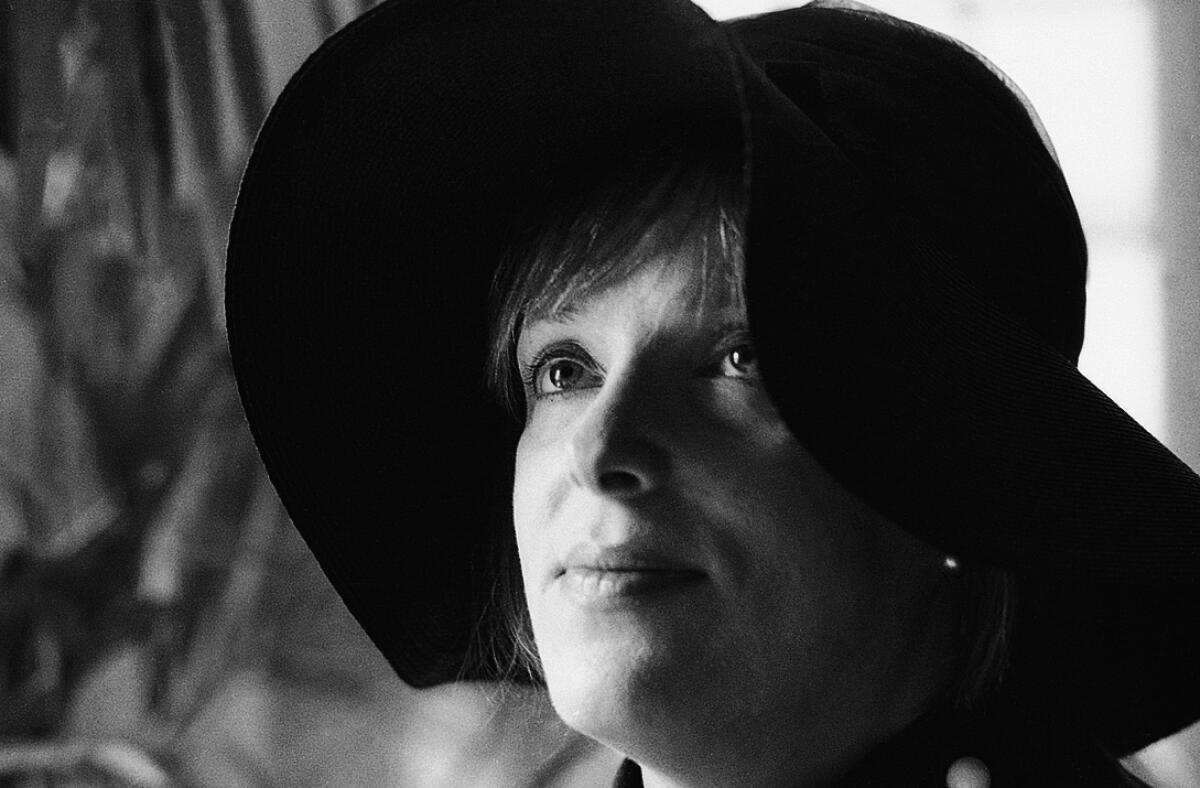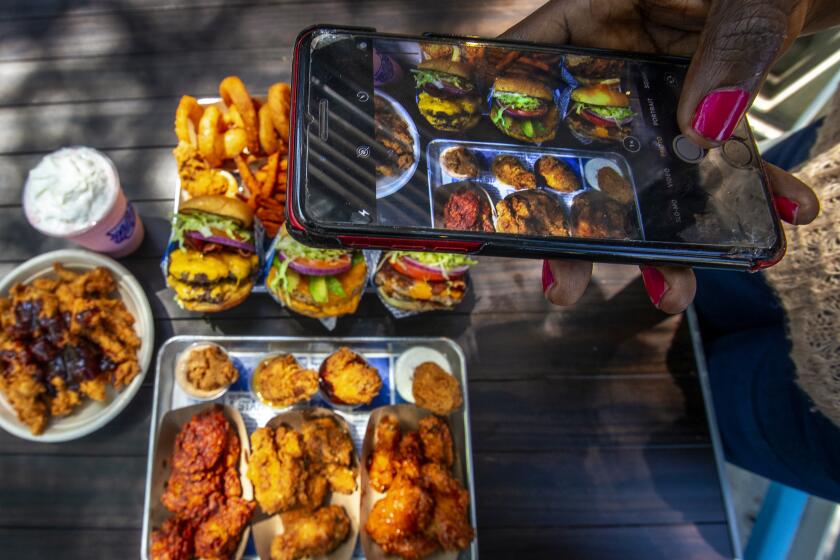But could she be trusted? How Gael Greene altered the course of restaurant criticism

Bill Addison considers the legacy of legendary New York magazine critic Gael Greene, who died Tuesday at age 88.
- Share via
For several years before catching my first break as a restaurant critic in 2002, when I began writing regularly for an alt weekly in Atlanta, I made a practice out of learning the form. My means of study sound like an absurd relic now: I filled a thick binder full of restaurants reviews, written by the country’s most compelling critics. I printed them off the Internet, pre-paywalls, often when I was bored at temp jobs.
Among my study material was a piece I returned to many times for its sweep, intelligence and boldness. It published in 2000 with the headline “Gold-Plate Special,” a review written by Gael Greene, who had been New York magazine’s critic since 1968.
Greene, who died of cancer Nov. 1 at age 88, was one of the masterminds of modern restaurant criticism.
Greene crafted dining reviews into a literary form. She came to the job at a time when straightforward observations of an establishment’s food, atmosphere and service, smattered with wit and the occasional scathing invective, defined the genre. She was a reporter but also frequently made herself a character. Her prose was unapologetically lush; she was a proud sensualist who wrote two erotic novels during her career. In her reviews, barbs often landed like the well-made beurre blanc she must have eaten so often in the days of New York’s French-dominated gastronomy: vinegary, suave and cohesive.
Take the “Gold-Plate Special” essay. It a was critique about Alain Ducasse at the Essex House, but also a broader social narrative around the famous chef’s entry into the Manhattan dining world. The piece details several meals but equally traces the arc of the restaurant’s reception by New Yorkers. What began as starry-eyed public fawning — among the circles that cared about such arrivals, anyway — had descended into general incredulity over the exorbitant prices and uneven food.
The consensus seems to be that the sex crowd didn’t think there was enough sex and the food crowd didn’t think there was enough food.
— Gael Greene, on her memoir
Greene’s review is 4,000 words, nearly four times the length of a standard review, then and now, and a testament to the space that magazines would still give writers at the turn of the millennium. Yet the piece glides. The insults are amazing. A roulade of sole is “pathetic.” She says of a rye tuile flavored with sun-dried tomato and Parmesan and presented with much flourish: “I taste another just to be sure. It’s not even a big nothing. It’s a small embarrassing nothing.”
When she does finally love something — a pear dessert? “I’m in a waltz now with Fred Astaire. I’m cuter than Ginger, sexier than Rita, more graceful than Cyd.”
In the center of the piece, she details an in-person breakfast meeting she has with Ducasse. She writes: “‘You are the talk of New York, Alain,’ I begin.” She tells us he grins at her words, but the reader is already wincing and maybe chuckling a little meanly. This isn’t going to be pretty.
I have posed for pictures shrouded in gauze, wearing a dinosaur mask and shaded into a Hitchcockian silhouette.
Greene was born in Detroit. She worked as a reporter for the New York Post and freelanced for Cosmopolitan, Mademoiselle and other publications before being hired by New York magazine, where she held the position of restaurant critic for 40 years. When Adam Platt was given the title of critic in 2002, Greene wrote a part-time column for six additional years. She was laid off in 2008.
“It was narcissistic shock: moi?” she told the New York Times then of the news. “I thought I was a brand at New York magazine.”
Between those two seismic shifts in her professional life, she wrote a memoir, “Insatiable: Tales From a Life of Delicious Excess,” published in 2006, and maintained a website, insatiable-critic.com, where she cached many of her most memorable reviews and continued writing dining dispatches until 2020.
In her memoir, she described tours of duty through France’s Michelin-starred restaurants and revealed a dalliance with Elvis (who, she said, asked her to order him a fried egg sandwich from room service) as well as affairs with Burt Reynolds, Clint Eastwood and some of the chefs whose restaurants she critiqued. She defended her editorial decisions by disclosing the relationships in print, as in the 1977 review “I Love Le Cirque But Can I Be Trusted?”
“The [memoir] didn’t do as well as everyone hoped it would,” Greene told me over lunch in New York in 2016. “The consensus seems to be that the sex crowd didn’t think there was enough sex and the food crowd didn’t think there was enough food.”
Two newspaper restaurant critics take some cues from food influencers but stick with traditional rules — like no free meals.
I was Eater’s national critic at the time and had started a passion project — an oral history of the women who led the way in American restaurant criticism — that I’m sorry to say I‘ve never completed. Greene was famous for her collection of hats; she wore them at public events and when she was being photographed, so that when she went hatless on reviews, she reasoned, she was less likely to be recognized.
I had met Greene on a couple of previous occasions and always felt awed by her ebullient grandness. She would toss her head back when she roared her husky, knowing laugh.
Restaurant criticism is a strange, singular, necessarily changing and sadly disappearing profession. Lifers in the field will likely cease to exist, and there are strong arguments why that should be the case. But Greene was a live-out-loud force whose path, even as she blazed it, vanished behind her. I trust she would not mind me sharing that during lunch in 2016 — over risotto and roasted salmon at Lincoln Ristorante, her choice — I sensed she wondered about her place in the world. She was buoyed by her work with Citymeals on Wheels, an organization to help feed New York’s homebound elderly that she co-founded with James Beard in 1981. Citymeals delivered more than 67 million meals during her lifetime.
Did she feel adequately recognized for her contributions to American food writing? I can’t say. Over a few bites of gelato at dessert, I told her about my binder and quoted a couple of lines from “Gold-Plate Special,” and she bellowed her laugh. I hope she took in my gratitude.
More to Read
Eat your way across L.A.
Get our weekly Tasting Notes newsletter for reviews, news and more.
You may occasionally receive promotional content from the Los Angeles Times.












